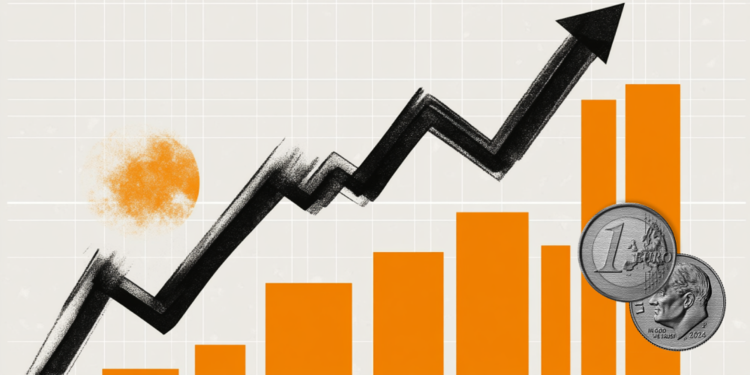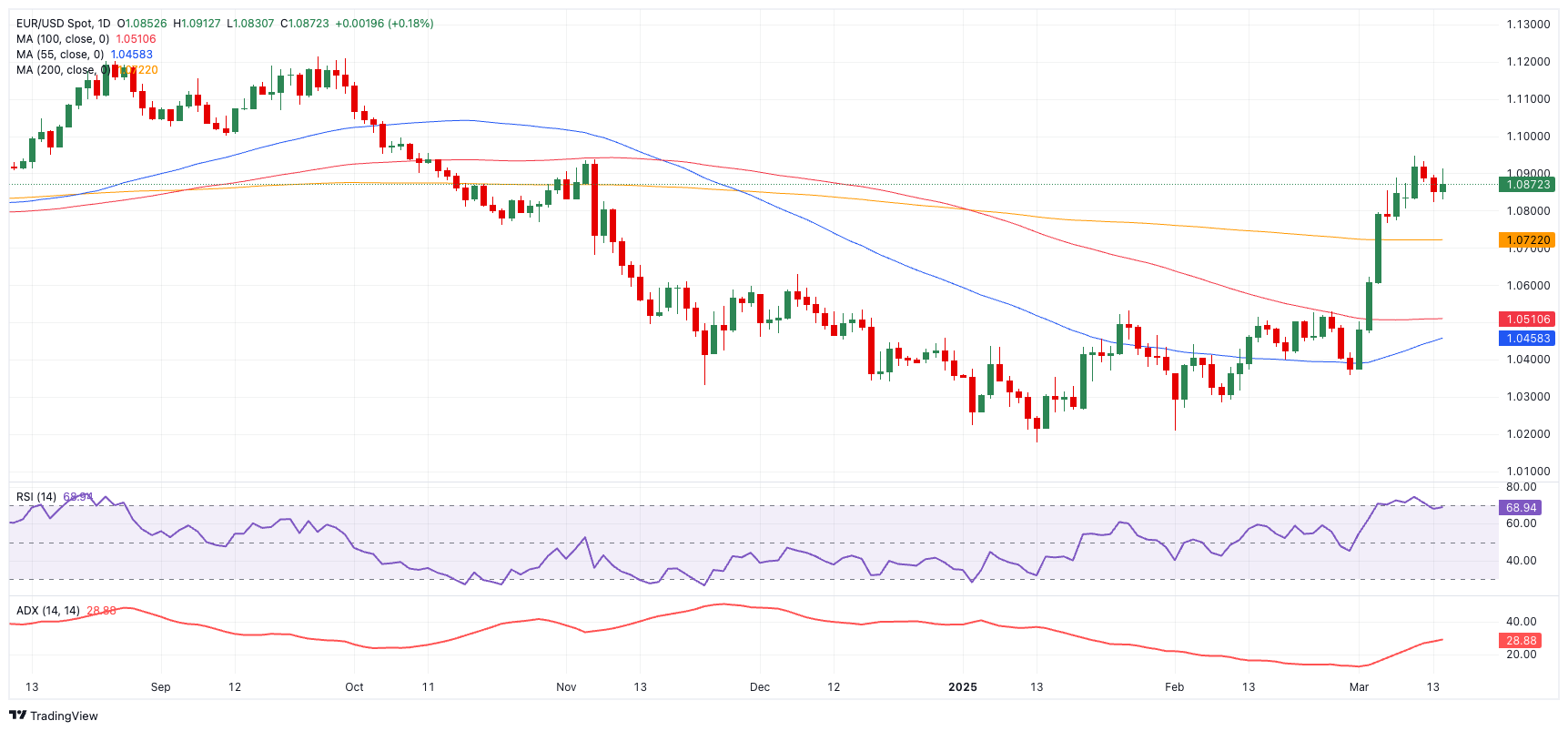- EUR/USD advanced for the second consecutive week and targets 1.1000.
- The US Dollar navigated the lower end of the range near recent lows.
- The Fed is expected to leave its interest rates unchanged next week.
EUR/USD enjoyed a broadly upbeat run this week, extending its strong recovery and briefly surpassing the 1.0900 handle to reach multi-month highs. Although the rally lost some momentum as the week wore on, the pair still ended with a solid performance on the weekly chart.
The German factor: “Whatever it takes 2.0”
Much of the Euro’s strength stemmed from encouraging developments in German politics.
In fact, Chancellor-in-waiting Friedrich Merz announced he had won over the Greens for a major borrowing initiative—clearing the way for the outgoing parliament to pass it next week. Merz’s conservative bloc and the Social Democrats had already proposed a €500 billion infrastructure fund alongside major borrowing reforms to bolster defense and jump-start growth in Europe’s largest economy. With the Greens now on board, they have the two-thirds majority needed to amend the constitution.
Merz defended the urgency of this package by pointing to shifting United States (US) policies under President Donald Trump, warning that a hostile Russia and an unreliable United States could leave Europe vulnerable. As part of the compromise, €100 billion of the proposed infrastructure fund will go toward climate action and economic transformation.
Trade turmoil and a volatile US Dollar
Lingering trade tensions also played a role in this week’s currency moves. President Trump’s unpredictable tariff policies continue to rattle markets, adding layers of uncertainty around the global economic outlook and the Federal Reserve’s (Fed) policy path.
After Canada and Mexico were given a temporary reprieve until April 2, the US administration threatened a 200% tariff on champagne and other European alcoholic beverages. This came in response to the EU’s plan to impose tariffs on $28 billion worth of US goods—including a 50% levy on whiskey—to counter American duties on steel and aluminum. Tariffs can fuel inflation and potentially nudge the Fed toward more aggressive tightening, but they can also dampen economic expansion—two competing forces that keep the Greenback’s trajectory murky.
Russia-Ukraine developments: A tailwind for the Euro
Meanwhile, the Euro has found support from hopeful signs of progress in Russia-Ukraine peace negotiations. Tensions cooled slightly after a high-stakes meeting between Presidents Trump and Zelenskyy. When geopolitical risks recede, markets often gravitate toward riskier assets—benefiting currencies like the Euro.
Central bank divergence
On the monetary policy front, the Fed has kept its target range at 4.25%–4.50%, with Chair Jerome Powell highlighting solid US fundamentals, subdued inflation, and a tight labor market. However, trade-related price pressures could complicate the central bank’s plans. Across the Atlantic, the European Central Bank (ECB) lowered key rates by 25 basis points and hinted it might ease further if uncertainty persists. Policymakers also trimmed Eurozone growth forecasts while slightly raising short-term inflation projections, although they still see inflation moderating by 2026.
Technical views
The first hurdle for EUR/USD sits at 1.0946 (March 11 high for 2025). A break above that exposes 1.0969 (23.6% Fibonacci retracement), followed by the psychological 1.1000 mark.
On the downside, the 200-day SMA at 1.0725 serves as initial support, followed by the 100-day SMA at 1.0518 and the 55-day SMA at 1.0458. Deeper floors emerge at 1.0359 (February 28 low), 1.0282 (February 10 low), 1.0209 (February 3 low), and 1.0176 (January 13 bottom for 2025).
The RSI hovers around the 70 yardstick, indicating a slight pullback from overbought territory, while the ADX near 30 suggests the uptrend remains firm.
EUR/USD daily chart
Short-term outlook
All told, EUR/USD appears well-positioned for further gains, underpinned by Germany’s policy breakthroughs and ongoing US Dollar volatility. However, the pair remains at the mercy of trade tensions, geopolitical headlines, and central bank developments—a trio of factors sure to keep traders on their toes.
German economy FAQs
The German economy has a significant impact on the Euro due to its status as the largest economy within the Eurozone. Germany’s economic performance, its GDP, employment, and inflation, can greatly influence the overall stability and confidence in the Euro. As Germany’s economy strengthens, it can bolster the Euro’s value, while the opposite is true if it weakens. Overall, the German economy plays a crucial role in shaping the Euro’s strength and perception in global markets.
Germany is the largest economy in the Eurozone and therefore an influential actor in the region. During the Eurozone sovereign debt crisis in 2009-12, Germany was pivotal in setting up various stability funds to bail out debtor countries. It took a leadership role in the implementation of the ‘Fiscal Compact’ following the crisis – a set of more stringent rules to manage member states’ finances and punish ‘debt sinners’. Germany spearheaded a culture of ‘Financial Stability’ and the German economic model has been widely used as a blueprint for economic growth by fellow Eurozone members.
Bunds are bonds issued by the German government. Like all bonds they pay holders a regular interest payment, or coupon, followed by the full value of the loan, or principal, at maturity. Because Germany has the largest economy in the Eurozone, Bunds are used as a benchmark for other European government bonds. Long-term Bunds are viewed as a solid, risk-free investment as they are backed by the full faith and credit of the German nation. For this reason they are treated as a safe-haven by investors – gaining in value in times of crisis, whilst falling during periods of prosperity.
German Bund Yields measure the annual return an investor can expect from holding German government bonds, or Bunds. Like other bonds, Bunds pay holders interest at regular intervals, called the ‘coupon’, followed by the full value of the bond at maturity. Whilst the coupon is fixed, the Yield varies as it takes into account changes in the bond’s price, and it is therefore considered a more accurate reflection of return. A decline in the bund’s price raises the coupon as a percentage of the loan, resulting in a higher Yield and vice versa for a rise. This explains why Bund Yields move inversely to prices.
The Bundesbank is the central bank of Germany. It plays a key role in implementing monetary policy within Germany, and central banks in the region more broadly. Its goal is price stability, or keeping inflation low and predictable. It is responsible for ensuring the smooth operation of payment systems in Germany and participates in the oversight of financial institutions. The Bundesbank has a reputation for being conservative, prioritizing the fight against inflation over economic growth. It has been influential in the setup and policy of the European Central Bank (ECB).


